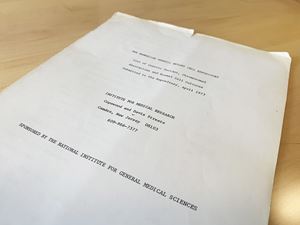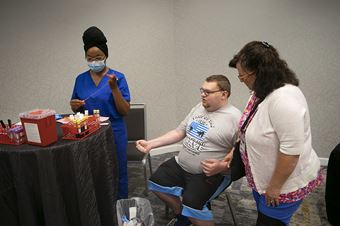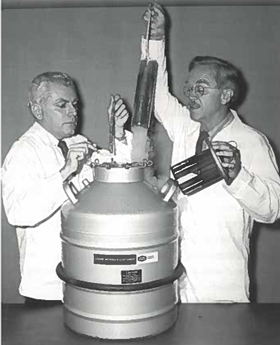The National Institute of General Medical Sciences’ Human Genetic Cell Repository is celebrating 50 years since its creation at the Coriell Institute for Medical Research!
First established at Coriell in 1972, this collection of cells and DNA is one of the very first at Coriell and is an extension of our founder Dr. Lewis L. Coriell’s mission: To provide scientists around the world with standardized biomaterials of the highest quality to support research.
The collection started small. Released in 1973, its first catalog was came in at fewer than two dozen pages, listing cell lines representing just a small number of genetic disorders and chromosomal abnormalities.
 In the decades to follow, the collection grew and grew. By the mid-1990s, the NIGMS Human Genetic Cell Repository (NIGMS HGCR) catalog filled more than 1,000 pages and contained a wide variety of collections—cell lines and DNA representing human inherited genetic disorders, apparently healthy controls, human amniotic fluid cultures, fibroblasts representing chromosomal abnormalities, cell lines representing human populations from different geographic locations as well as different species, and much, much more.
In the decades to follow, the collection grew and grew. By the mid-1990s, the NIGMS Human Genetic Cell Repository (NIGMS HGCR) catalog filled more than 1,000 pages and contained a wide variety of collections—cell lines and DNA representing human inherited genetic disorders, apparently healthy controls, human amniotic fluid cultures, fibroblasts representing chromosomal abnormalities, cell lines representing human populations from different geographic locations as well as different species, and much, much more.
Now, this repository of cell lines and DNA is even more significant. The samples number in the many thousands and include induced pluripotent stem cells and, thankfully, all can now be accessed with their associated data in Coriell’s online catalog.
The samples in this collection have been essential to advancing our understanding of biology and disease and have been especially important in the fields of genetics and genomics. Over a thousand rare genetic diseases are represented in the collection, with many samples being the only cell lines available in the world to scientists to study that disease.
The Genome in a Bottle Consortium at the National Institute of Standards and Technology (NIST) selected a number of samples from the NIGMS HGCR to develop into highly characterized, world-renown standardized reference samples for human genome sequencing.
The invaluable ACMG 73 lines are also held within the NIGMS HGCR collection at Coriell. This group of samples have known mutations in genes identified by the American College of Medical Genetics and Genomics to cause disorders that have known clinical interventions. These samples continue to be used in bettering the identification and treatment for these disorders.
The NIGMS HGCR also offers cell lines and DNA samples from many participants in the Personal Genome Project (PGP), a large cohort study that sequenced the complete genomes of thousands of people. The collection also includes the famous CEPH Utah population samples from the HapMap consortium and 1000 Genomes Project.
“The partnerships that the NIGMS Repository has formed over the last several decades have established it as a one-of-a-kind resource in human genetics,” said Nahid Turan, Coriell’s Chief Biobanking Officer and the Principal Investigator for the collection at Coriell. “The samples in this repository include some of the most important, most impactful, and most historically unique in the field.”
The NIGMS HGCR’s focus on rare, heritable disease goes back to the very beginning of the collection’s mission. What started as a collection of dozens of samples now includes many thousands, representing more than a thousand known genetic diseases.
This collection grew organically, through cooperation with doctors and geneticists, with people affected by rare disease and their families, and the advocacy groups that represent these communities and fight for awareness, research, treatments, and cures.
 Today, the collection continues to accept blood and tissue donations from all affected by heritable diseases and chromosomal abnormalities. The NIGMS Repository Team at Coriell regularly works with disease advocacy groups to organize mass collections and helps these time- and cash-strapped groups contribute to this collection at no cost.
Today, the collection continues to accept blood and tissue donations from all affected by heritable diseases and chromosomal abnormalities. The NIGMS Repository Team at Coriell regularly works with disease advocacy groups to organize mass collections and helps these time- and cash-strapped groups contribute to this collection at no cost.
“You donate blood one time and you’ve contributed to this vast wealth and future that can improve things not just for yourself, but all patients,” said Danaé Bartke, Executive Director of HCU Network America, a rare disease advocacy group for homocystinuria. “If we’re ever going to have a better understanding and develop better therapies for our diseases, we all need to be in this together. Not just researchers, not just the pharmaceutical industry bringing these therapies to market. It’s everyone working together to make it happen.”
When someone donates a sample to the NIGMS HGCR collection, the scientific potential is limitless. Rare disease samples are used for the study of these diseases, of course, but can also be used to learn more about biology, genetics and health generally and find new, potentially unexpected, ways to battle these and other ailments.
For example, in the last decade, samples from the NIGMS HGCR collection donated by individuals affected by Niemann-Pick Type C, a rare and ultimately fatal neurological disorder diagnosed mainly in children, were used in developing a novel vaccine against the Ebola virus. Researchers were able to determine that Ebola virus cell entry and replication relies on NPC1, a cholesterol transport protein which if mutated, is known to cause a form of Niemann-Pick disease.
When one donates to the NIGMS HGCR collection, it’s impossible to know all of the ways that a contribution may be used to improve human health.
 A critical factor of managing this invaluable collection is the importance of shepherding it into the future, ensuring it’s relevancy for many decades to come still. That has meant continuing to grow the collection itself, adding newer samples with the most current and comprehensive data to go along with them. For a collection as long-established as this one, it’s crucial to update and grow at the same time, as there are still may unrepresented rare diseases.
A critical factor of managing this invaluable collection is the importance of shepherding it into the future, ensuring it’s relevancy for many decades to come still. That has meant continuing to grow the collection itself, adding newer samples with the most current and comprehensive data to go along with them. For a collection as long-established as this one, it’s crucial to update and grow at the same time, as there are still may unrepresented rare diseases.
It also means adding new sample and product types and better representing human ethnic diversity, to answer the needs of scientists as the field and technology advances. The inclusion of induced pluripotent stem cells (iPSCs) has been a major focus of the collection since iPSCs were discovered. These powerful cell lines allow scientists to grow nearly any type of cell in the dish and accelerate research in many areas, including drug discovery and therapeutics.
Beyond iPSCs, the collection recently added High Molecular Weight DNA. HMW DNA allows for long-read next generation sequencing, allowing scientists to better characterize structural variation in regions of the genome that may be more challenging with other approaches.
In 1985, when Dr. Coriell retired from what was then known as the Institute for Medical Research (later renamed in his honor), he received a letter of gratitude from Fred H. Bergmann, PhD, Director for the Genetics Program at the NIGMS.
“Upon the occasion of your retirement, I want to let you know how much I have benefited from your advice during the initial phases of thinking about the possibility of setting up a bank of cells some thirteen of fourteen years ago,” Bergmann wrote. “It was your wise guidance that helped keep the project on an even keel, and contributed to its present success.”
The Coriell Institute for Medical Research is honored by the successes of this lasting partnership and the opportunity to support and develop this collection for the future.